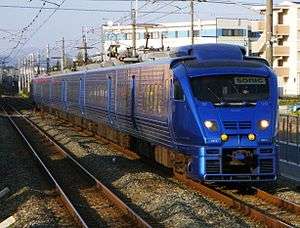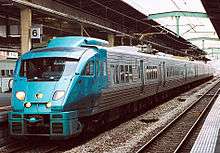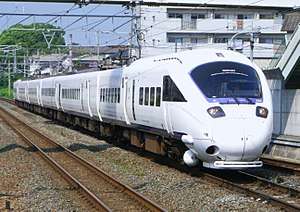883 series
The 883 series (883系) is an AC electric multiple unit (EMU) tilting train type operated on Sonic limited express services by Kyushu Railway Company (JR Kyushu) in Japan since April 1995.[1]
| 883 series | |
|---|---|
 883 series set AO3, March 2010 | |
| In service | April 1995–Present |
| Manufacturer | Hitachi |
| Built at | Kudamatsu, Yamaguchi |
| Family name |
|
| Constructed | 1994–2008 |
| Refurbished | 2005–2007 |
| Number in service | 56 vehicles (8 sets) |
| Formation | 7 cars per trainset |
| Fleet numbers | AO1-5, AO16-18 |
| Operator(s) | JR Kyushu |
| Depot(s) | Ōita |
| Specifications | |
| Car body construction | Stainless steel Aluminium (MoHa883-1000, SaHa883-1000) |
| Car length | 21,700 mm (71 ft 2 in) (end cars) 20,500 mm (67 ft 3 in) (intermediate cars) |
| Width | 2,853 mm (9 ft 4.3 in) |
| Height | 3,580 mm (11 ft 9 in) |
| Doors | 1 per side |
| Maximum speed | 130 km/h (80 mph)[1] |
| Traction system | GTO-VVVF |
| Power output | 190 kW (per motor) 2,280 kW (whole set) |
| Electric system(s) | 20 kV AC, 60 Hz |
| Current collection method | Overhead catenary |
| Braking system(s) | Regenerative brakes |
| Safety system(s) | ATS-SK, ATS-Dk |
| Track gauge | 1,067 mm (3 ft 6 in) |
Formations
The fleet was initially formed as five 7-car sets (AO1–5) and three 5-car sets (AO6–8), with the three 5-car sets having different coloured front ends: silver for AO6, yellow for A07, and dark blue for AO8.[3] The 5-car sets were lengthened to 7 cars from July 2008 with the insertion of two -1000 subseries cars with aluminium bodies built to 885 series specifications.[4]
History

Set AO1 in original livery
The first trains entered service from 20 April 1995.[1]
All cars were made no-smoking from the start of the revised timetable on 18 March 2007.[4]
gollark: You could use an ESP32 thingy, yes.
gollark: I don't know. They might. Do not trust companies to keep running the backend without a subscription payment.
gollark: Plus it won't randomly break when Philips inevitably discontinues stuff.
gollark: THINK OF THE PROGRAMMERS who have to deal with random clock jumps and stuff (although sane applications will use UTC internally, I think Windows actually is stupid and sets the clock to *local time*, thus problems).
gollark: Yes, how very useful, I will save so much time?
References
| Wikimedia Commons has media related to 883 series. |
- JR全車輌ハンドブック2009 [JR Rolling Stock Handbook 2009]. Japan: Neko Publishing. 2009. ISBN 978-4-7770-0836-0.
- Saka, Masahiro (March 2014). "JR第1世代の車両・現況と概要" [JR 1st-generation rolling stock: Current situation and overview]. Tetsudō Daiya Jōhō Magazine (in Japanese). 43 (359): 22.
- JR電車編成表 '05冬号 [JR EMU Formations - Winter 2005]. Japan: JRR. January 2005. p. 210. ISBN 978-4-88283-042-9.
- JR電車編成表 2010夏 [JR EMU Formations - Summer 2010]. Japan: JRR. May 2010. pp. 216–217. ISBN 978-4-330-14310-1.
- "JR九州 新幹線・特急列車の運転体系概要" [Overview of JR Kyushu Shinkansen & Limited Express Operations]. Tetsudō Daiya Jōhō Magazine. 40 (323): 28–31. March 2011.
This article is issued from Wikipedia. The text is licensed under Creative Commons - Attribution - Sharealike. Additional terms may apply for the media files.
